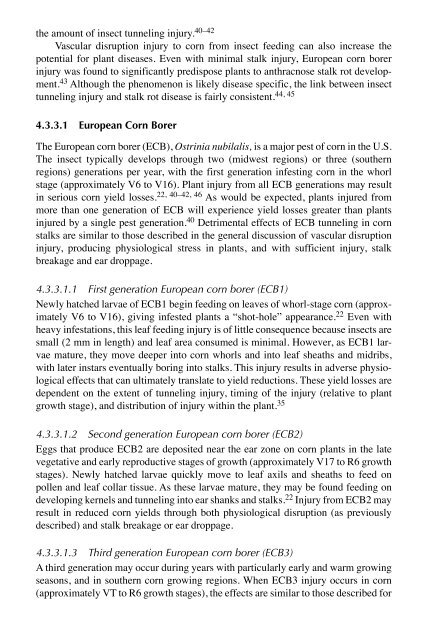Biotic Stress and Yield Loss
Biotic Stress and Yield Loss
Biotic Stress and Yield Loss
- No tags were found...
You also want an ePaper? Increase the reach of your titles
YUMPU automatically turns print PDFs into web optimized ePapers that Google loves.
the amount of insect tunneling injury. 40–42Vascular disruption injury to corn from insect feeding can also increase thepotential for plant diseases. Even with minimal stalk injury, European corn borerinjury was found to significantly predispose plants to anthracnose stalk rot development.43 Although the phenomenon is likely disease specific, the link between insecttunneling injury <strong>and</strong> stalk rot disease is fairly consistent.44, 454.3.3.1 European Corn BorerThe European corn borer (ECB), Ostrinia nubilalis, is a major pest of corn in the U.S.The insect typically develops through two (midwest regions) or three (southernregions) generations per year, with the first generation infesting corn in the whorlstage (approximately V6 to V16). Plant injury from all ECB generations may resultin serious corn yield losses. 22, 40–42, 46 As would be expected, plants injured frommore than one generation of ECB will experience yield losses greater than plantsinjured by a single pest generation. 40 Detrimental effects of ECB tunneling in cornstalks are similar to those described in the general discussion of vascular disruptioninjury, producing physiological stress in plants, <strong>and</strong> with sufficient injury, stalkbreakage <strong>and</strong> ear droppage.4.3.3.1.1 First generation European corn borer (ECB1)Newly hatched larvae of ECB1 begin feeding on leaves of whorl-stage corn (approximatelyV6 to V16), giving infested plants a “shot-hole” appearance. 22 Even withheavy infestations, this leaf feeding injury is of little consequence because insects aresmall (2 mm in length) <strong>and</strong> leaf area consumed is minimal. However, as ECB1 larvaemature, they move deeper into corn whorls <strong>and</strong> into leaf sheaths <strong>and</strong> midribs,with later instars eventually boring into stalks. This injury results in adverse physiologicaleffects that can ultimately translate to yield reductions. These yield losses aredependent on the extent of tunneling injury, timing of the injury (relative to plantgrowth stage), <strong>and</strong> distribution of injury within the plant. 354.3.3.1.2 Second generation European corn borer (ECB2)Eggs that produce ECB2 are deposited near the ear zone on corn plants in the latevegetative <strong>and</strong> early reproductive stages of growth (approximately V17 to R6 growthstages). Newly hatched larvae quickly move to leaf axils <strong>and</strong> sheaths to feed onpollen <strong>and</strong> leaf collar tissue. As these larvae mature, they may be found feeding ondeveloping kernels <strong>and</strong> tunneling into ear shanks <strong>and</strong> stalks. 22 Injury from ECB2 mayresult in reduced corn yields through both physiological disruption (as previouslydescribed) <strong>and</strong> stalk breakage or ear droppage.4.3.3.1.3 Third generation European corn borer (ECB3)A third generation may occur during years with particularly early <strong>and</strong> warm growingseasons, <strong>and</strong> in southern corn growing regions. When ECB3 injury occurs in corn(approximately VT to R6 growth stages), the effects are similar to those described for

















